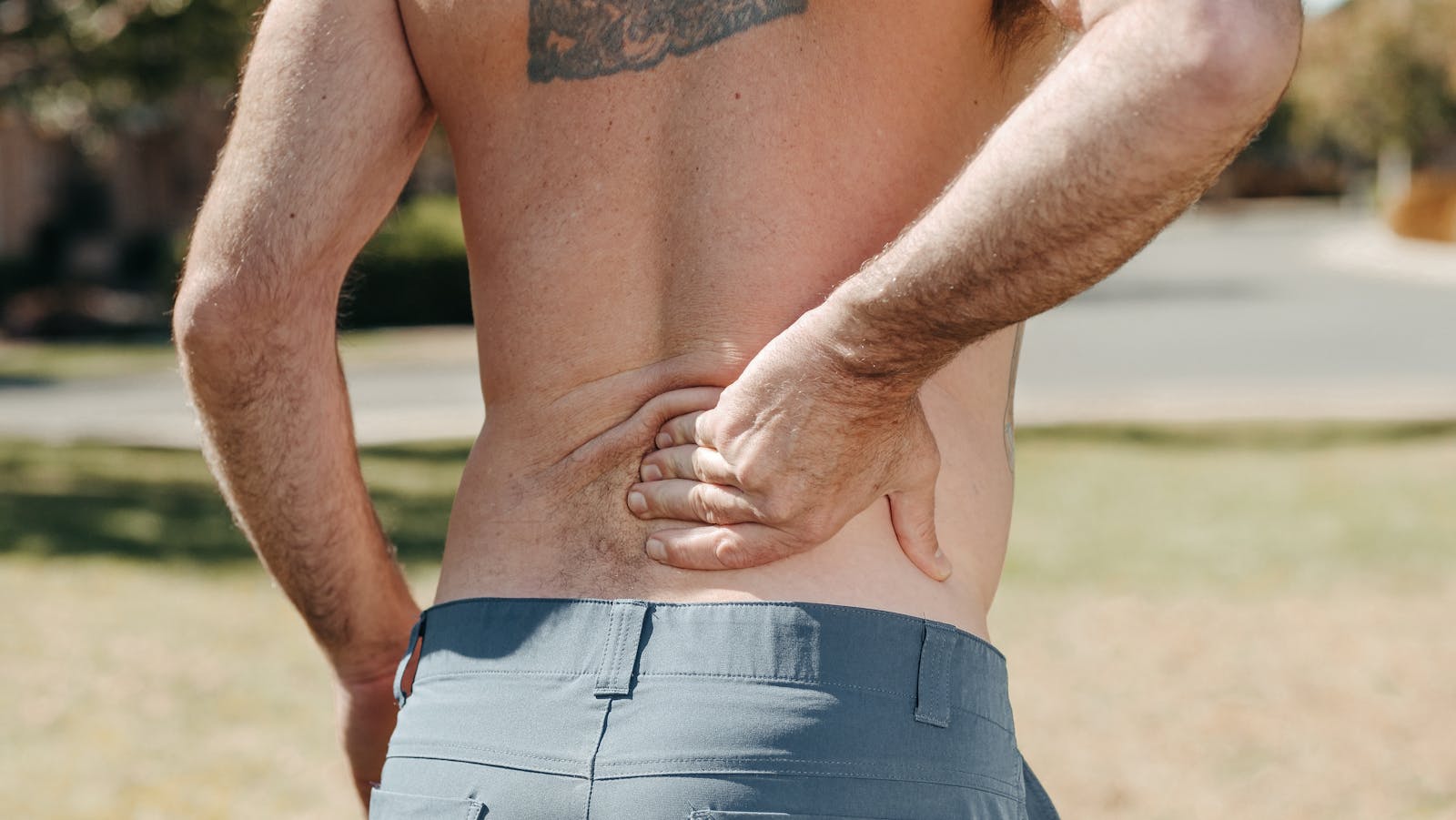The intricate synergy of muscles in the lower back, including the erector spinae, quadratus lumborum, and the psoas major, plays a significant role in a myriad of daily functions ranging from maintaining a stable posture to enabling complex movements. However, the complexities pertaining to these muscles are often underestimated, leading to preventable injuries and chronic discomfort. As we explore the depth of their structures, function, and the role they play in overall health, we may uncover potential strategies to enhance their strength and resilience, consequently paving the way for improved quality of life.
Understanding Lower Back Anatomy
Often overlooked, the anatomy of the lower back is a complex interplay of muscles, ligaments, tendons, and bones that work synergistically to enable our everyday movements. The primary role of this intricate system is spinal cord protection, which is achieved via the vertebral column, a robust structure that houses and safeguards the delicate spinal cord.
The lower back, also known as the lumbar region, is composed of five vertebrae, named L1 to L5. These vertebrae are designed to bear the body’s weight and are larger than their counterparts in the cervical (neck) and thoracic (chest) regions. Each vertebra is cushioned by an intervertebral disc to absorb shocks and prevent bone rubbing against bone.
However, these discs are not impervious to damage. A prevalent issue is disc herniation, one of the leading herniated disc causes. This condition occurs when the soft, gelatinous nucleus of the disc leaks out through a tear in the tougher, outer ring, leading to nerve impingement and consequent pain. Understanding this complex anatomy and its potential pathologies is crucial in the prevention, diagnosis, and treatment of lower back pain.
Primary Functions of Lower Back Muscles
The lower back muscles serve two crucial roles: understanding the muscle anatomy and their role in body support. Comprehending the anatomical structure is essential to appreciate their physiological function. This knowledge also elucidates their indispensable contribution in offering structural integrity to the body, enabling movement, and ensuring stability.
Understanding Muscle Anatomy
Diving into the intricate anatomy of lower back muscles, we find that these muscles primarily serve two essential functions: providing stability to the spine and enabling a wide range of movements. These muscles exhibit a high degree of muscle flexibility, allowing us to bend, turn, and twist our bodies. They are composed of both slow-twitch and fast-twitch fibers, each with specific properties and functions. Slow-twitch fibers provide endurance and are less prone to fatigue, while fast-twitch fibers contribute to the power and speed of movements. Muscle hypertrophy, or the increase in muscle mass, is also a key aspect of lower back muscle anatomy. This process, stimulated by activities such as weightlifting and resistance training, strengthens these muscles, thereby enhancing their functional capabilities.
Role in Body Support
Expanding on their intricate anatomy, the primary functions of lower back muscles center around body support, providing stability to the spine, and facilitating a myriad of movements. These muscles play an essential role in maintaining core stability and spinal alignment, which are pivotal components of overall body posture and movement.
The primary functions of the lower back muscles can be detailed as follows:
- Spinal Alignment: The lower back muscles work in tandem with the spine to maintain proper alignment, which is critical for overall body balance.
- Core Stability: These muscles provide core stability, enabling the body to perform complex movements with ease.
- Movement Facilitation: The lower back muscles are instrumental in facilitating a range of movements – from simple bending to intricate motions.
- Body Support: Finally, these muscles offer body support, effectively carrying the body’s weight and reducing the strain on the spine.
The Role of Lumbar Spine
The lumbar spine, an integral component of the lower back, plays a significant role in human mobility and structural balance. Understanding its functionality and the impact on overall well-being necessitates a closer look at its role in facilitating movement, providing structural support, and protecting the spinal cord. Additionally, maintaining the health of the lumbar spine through proper posture, regular exercise, and preventive care is paramount in preventing back injuries and ensuring peak function.
Lumbar Spine Functionality
In evaluating the pivotal role of the lumbar spine, it becomes evident that this region is integral to a myriad of bodily functions, most prominently providing structural support and facilitating movement. Interconnected spinal curvature and disc degeneration are two key aspects of its functionality.
- Structural Support: The lumbar spine bears the weight of the upper body, maintaining balance and alignment.
- Facilitating Movement: It serves as a pivot for the torso’s movement, allowing for bending and twisting.
- Spinal Curvature: The natural curve of the lumbar region helps absorb shock, reducing risk of injury.
- Disc Degeneration: Aging causes the discs to lose hydration, affecting their ability to cushion the vertebrae. This process can influence the spine’s overall functionality and health.
Lumbar Spine Health Maintenance
Maintaining the health of the lumbar spine is paramount as it plays a critical role in overall body mechanics, acting as both a sturdy structural pillar and a flexible conduit for movement. The Lumbar Spine Diet, which emphasizes ingestion of nutrients beneficial to spine health like calcium and vitamin D, can greatly help in preserving the lumbar spine’s integrity. Additionally, the sleep impact on lumbar health should not be underestimated. Proper sleep positions can alleviate stress on the lumbar spine, preventing potential damage. In addition, a good quality mattress and pillow can provide the necessary support to maintain the natural curvature of the spine during sleep. Therefore, diet and sleep are integral components in the maintenance of lumbar spine health.
Common Lower Back Muscle Groups
Delving into the intricacies of the lower back, one finds several key muscle groups that play important roles in movement and stability. These muscles, often underappreciated, are essential for a wide range of activities and their health is essential for overall well-being. Proper care through muscle recovery processes and understanding the massage benefits for these muscle groups can greatly enhance function and prevent discomfort.
The main muscle groups in the lower back are:
- Erector Spinae: This group of muscles and tendons run along the spine and are responsible for the extension and rotation of the spine, contributing significantly to posture.
- Quadratus Lumborum: Often referred to as the ‘hip hiker’, this muscle helps to stabilize the lumbar spine while standing and walking.
- Psoas Major: Part of the hip flexors, it plays a key role in supporting the spine and affecting posture.
- Multifidus: This muscle provides stability and support to the vertebral column, preventing injury and enabling controlled movements.

Potential Injuries to Lower Back Muscles
Understanding the potential injuries to lower back muscles is vital, as they not only impact mobility but can also cause significant discomfort and chronic pain if not properly addressed. The lumbar area is particularly prone to strains due to the weight it supports and its involvement in movement. These strains can occur as a result of improper lifting, sudden movements, poor posture, or chronic overuse.
Injury prevention is essential to maintaining a healthy lower back. This includes practicing proper lifting techniques, engaging in regular physical activity to strengthen the back and core muscles, and maintaining a healthy posture. Additionally, ergonomic considerations at work and home can also contribute to injury prevention.
When an injury does occur, recovery techniques are crucial in promoting healing and preventing further damage. These may include rest, ice and heat therapy, physical therapy, and in some cases, medication or surgery. It’s important to remember that each individual and injury is unique, necessitating a personalized approach to recovery.
Recognizing Symptoms of Strains
One must be vigilant in recognizing the symptoms of strains in the lower back muscles, as early detection can greatly expedite the recovery process and prevent further complications. It is pivotal in minimizing the recovery timeline and aiding strain prevention.
The following symptoms are indicative of a potential strain:
- Pain and stiffness: This is often felt in the lower back area, which may intensify when bending, lifting, standing, or walking.
- Limited mobility: Difficulty in moving or a decrease in the range of motion might be experienced due to the strain.
- Muscle spasms: This could be an involuntary contraction of the muscles, causing discomfort or pain.
- Swelling or inflammation: This is the body’s natural response to injury and could indicate a strain.
The above symptoms should not be ignored as they may be indicative of a strain. Proper rest, physiotherapy, and prescribed medication are often part of the recovery process. However, strain prevention methods such as regular exercise, maintaining good posture, and lifting objects correctly, can be effective in preventing such injuries. Early detection and intervention are key to a quick and smooth recovery.
Professional Diagnosis of Back Pain
The professional diagnosis of back pain begins with accurately identifying symptoms associated with lower back muscles. This typically involves the strategic use of medical imaging techniques to visualize the affected area and pinpoint the source of discomfort. Once a diagnosis has been established, an array of treatment options can then be explored to effectively manage or alleviate the pain.
Identifying Lower Back Pain
Identifying lower back pain necessitates a thorough examination by a medical professional, who can accurately diagnose the condition based on the patient’s symptoms, medical history, and a physical assessment. Recognizing the triggers of pain and the emotional impacts it can have on patients are vital steps in this process.
To diagnose lower back pain, the following steps are typically followed:
- Thorough patient interview to understand the pain triggers and their frequency.
- Evaluation of the patient’s medical and family history.
- Detailed physical examination to assess the patient’s mobility, sensitivity, and strength.
- Consideration of the emotional impacts of the pain on the patient’s daily life.
This systematic approach ensures a thorough understanding of the patient’s condition, leading to a more effective treatment plan.
Role of Medical Imaging
Medical imaging plays an indispensable role in the professional diagnosis of back pain, providing vital insights into the underlying cause and severity of the condition. With the advent of imaging advancements such as Magnetic Resonance Imaging (MRI), Computed Tomography (CT) scans, and X-rays, physicians can thoroughly analyze the condition of lower back muscles and associated structures. These technologies enable the accurate identification of abnormalities like herniated discs, muscle degeneration, or fractures that could be causing the pain. The radiology benefits are twofold, facilitating both precise diagnosis and targeted treatment planning. This supports that the patient receives the most effective and appropriate care for their specific condition. As such, medical imaging serves as an important tool in the detailed assessment and management of back pain.
Treatment Options Explored
Frequently, the professional diagnosis of back pain propels a thorough exploration of various treatment options, allowing physicians to formulate an individualized, efficient, and effective therapeutic approach.
The treatment plan often comprises of:
- Pain Management Techniques: This could involve the use of medication, physical therapy, or a combination of both to alleviate pain and inflammation.
- Alternative Therapy Options: Acupuncture, massage, yoga, and chiropractic adjustments are considered here.
- Lifestyle Modifications: Including regular exercise, maintaining proper posture, and making dietary changes to support overall health.
- Surgical Interventions: In severe cases, surgical options like discectomy or spinal fusion may be recommended.
These approaches are carefully selected based on the patient’s specific condition, severity of pain, and lifestyle factors.
Importance of Posture for Back Health
Undeniably, maintaining an upright and balanced posture plays a paramount role in preserving the health of your lower back muscles. Posture correction devices and sitting ergonomics are essential tools that assist in maintaining this balance, thereby preventing strain and injury.
Posture correction devices, such as lumbar supports and posture corrector braces, are engineered to promote ideal spinal alignment. They function by gently pulling your shoulders back to prevent slouching, reducing the stress on your lower back muscles. These devices are particularly effective when used in conjunction with regular exercise and stretching routines, which also serve to strengthen the lower back muscles.
Sitting ergonomics, on the other hand, involve the science of designing and arranging workspace so that users can interact in the safest, most efficient, and most comfortable manner. They aim to enhance the relationship between the user and their environment, reducing the risk of musculoskeletal disorders. For instance, an ergonomically designed chair supports the natural curve of your spine, thereby minimizing the risk of lower back strain.
Therapeutic Measures for Relief
In the domain of therapeutic interventions, a myriad of measures exist that offer significant relief for strained lower back muscles. Massage therapy, a popular choice, uses hands-on manipulation to ease tension, increase blood flow, and promote relaxation in the affected muscles. Alongside massage therapy, physicians often propose a tailored pain management plan, which may include over-the-counter medications, prescription drugs, or even complementary therapies like acupuncture.
To further the understanding of these therapeutic measures, let’s enumerate four key methodologies:
- Massage Therapy: This involves manipulating the soft tissues of the body to alleviate discomfort. Skilled therapists can target specific lower back muscles, aiding in quicker recovery.
- Medication: Non-prescription drugs like ibuprofen can help manage pain and inflammation. For more severe cases, prescription pain relievers may be suitable.
- Heat and Ice Application: These can offer immediate relief. Ice packs may reduce inflammation and numb the area, while heat can relax tight muscles.
- Acupuncture: An age-old practice, it involves inserting fine needles at specific points on the body to relieve pain.
Each therapeutic measure possesses its unique benefits and can be chosen based on personal preference, medical advice, and severity of pain.
Exercises for Lower Back Strength
Building lower back strength is essential not only for alleviating existing pain, but also for preventing future strains, and this can be achieved through a targeted and regular exercise regimen. A multifaceted approach that combines back flexibility and core stability exercises can lead to significant improvements.
Firstly, back flexibility exercises are vital in expanding the range of motion and relieving muscle tension. Movements such as the seated lower back rotational stretch and the knee-to-chest stretch are particularly effective in enhancing flexibility.
Core stability, on the other hand, focuses on the muscles around the spine, abdomen, and pelvic region. Strengthening these muscles improves posture, provides better support for the lower back, and reduces the risk of injury. Planks, bridges, and bird dogs are core stability exercises that effectively target these muscle groups.
Preventing Future Lower Back Problems
To safeguard against future lower back issues, preventive measures that encompass lifestyle modifications, regular physical activity, and proper ergonomics are paramount. These strategies help to maintain the health and flexibility of the lower back muscles, thereby reducing the risk of injury and discomfort.
It is important to understand the effects of a sedentary lifestyle on the lower back muscles. Sitting for prolonged periods can lead to weak and tight muscles, which are more prone to injury. Hence, regular physical activity is essential to keep these muscles strong and flexible.
Moreover, the significance of nutrition cannot be overstated. A balanced diet can provide the necessary vitamins and minerals for the health and repair of the lower back muscles.
In summary, preventing future lower back problems involves:
- Lifestyle modifications, such as reducing sitting time and incorporating more physical activity into daily routines.
- Regular physical activity, including exercises specifically designed to strengthen the lower back muscles.
- Proper ergonomics, particularly when sitting or lifting heavy objects, to protect the lower back muscles from strain.
- A balanced diet, to ensure the muscles receive the nutrients they need for best performance and repair.
These strategies, implemented consistently, can greatly reduce the risk of future lower back issues.
Frequently Asked Questions
What Specific Dietary Changes Can Support Lower Back Muscle Health?
Increasing protein intake can support muscle health by aiding in repair and growth. Hydration is also essential, as it facilitates nutrient delivery and maintains muscle elasticity, potentially reducing the risk of injuries and strain.
Do Emotional Factors Like Stress or Anxiety Affect Lower Back Muscles?
Yes, emotional factors such as stress or anxiety can have a physical impact on the body. These conditions can cause muscle tension and discomfort, which can be alleviated through stress management techniques and proper self-care.
What Are Common Misconceptions About Lower Back Muscle Pain?
Common misconceptions about muscle pain include the notions that rest is always beneficial, pain equates to damage, and that all discomfort requires medical intervention. These misunderstandings often overlook effective pain management techniques and the impacts of a sedentary lifestyle.
How Does Aging Impact the Strength and Flexibility of Lower Back Muscles?
Aging affects the spine considerably, often leading to decreased strength and flexibility. A sedentary lifestyle exacerbates these changes, increasing the likelihood of discomfort and impairment. Regular exercise can mitigate some of these effects, promoting overall back health.
Are There Any Specific Yoga Poses Beneficial for Lower Back Muscles?
Indeed, yoga offers numerous benefits with specific pose variations targeting different areas. Poses such as Child’s Pose, Cat-Cow Stretch, and Pigeon Pose are particularly beneficial for enhancing flexibility and strength in a non-specific muscle group.


